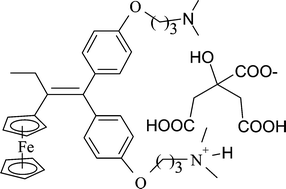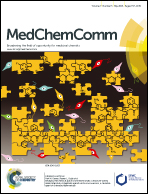Efficacy of a novel ferrocenyl diaryl butene citrate compound as a biocide for preventing healthcare-associated infections†
Abstract
The antiseptic and disinfectant potential of a formulation containing the tamoxifen analogue 1,1-bis[4-(3-dimethylaminopropoxy)phenyl]-2-ferrocenyl-but-1-ene citrate was assessed according to European standards and pharmacopeia in comparison with a commercial antiseptic product containing hexamidine diisethionate, chlorhexidine digluconate and chlorocresol as active ingredients. The formulation met the phase 1 requirement of reducing by 5 cycles the counts of microorganisms frequently involved in healthcare-associated infections, namely Escherichia coli ATCC 10536, Pseudomonas aeruginosa ATCC 15442, Staphylococcus aureus ATCC 6538, Enterococcus hirae ATCC 10541 and Candida albicans ATCC 10231. It also killed a clinical isolate of Acinetobacter baumannii which is highly resistant to antibiotics and antiseptics. In phase 2/step 2 tests, it reduced the counts of E. coli ATCC 10536 by 4 log cycles within 60 seconds on hands (standard EN 1499). The novel formula is a potent biocide, and this demonstration could lead to the development of a new commercial antiseptic.


 Please wait while we load your content...
Please wait while we load your content...